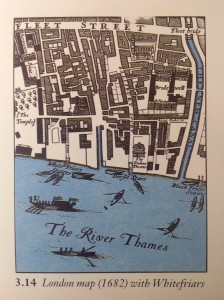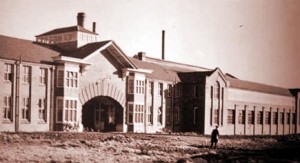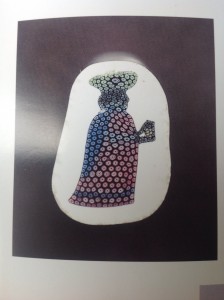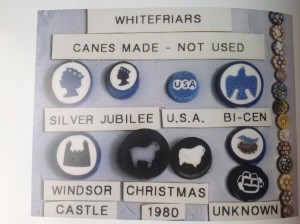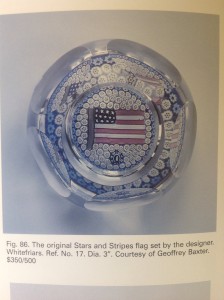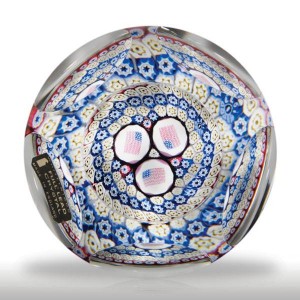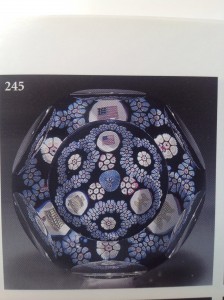On Whitefriars…
It is generally believed that the Whitefriars Glass Company of London was constructed in about 1680, shortly after the great fire of London. In all probability, its beginnings date back even further. A 1682 map
of London shows the glassworks as being near the Inns of Court in the Temple and very close to the River Thames. This location provided for easy transportation of clay and coal for the furnaces, sand and other materials needed for the making of glass. The glass company was named for the white-robed Carmelite monks who lived in a monastery that, until 1538, had been located on the site of the factory. The monastery was dissolved following the dispute between Henry VIII and the Pope over the King’s divorce. Even though the monastery was disbanded, the King did not repeal the ecclesiastic law of sanctuary, and for nearly sixty years the area remained a haven for “debtors, cutpurses, highwaymen, and all the blackguards of town.”
The glass factory itself had a tough reputation. In 1732, the Whitehall Evening Post reported on a clash between members of the Royal Navy and the glassblowers:
“Yesterday a Press Gang [a company under an officer detailed to press men into military or naval service] went into the glasshouse in White Fryars [sic] to press some of the men at work there, but they no sooner got in but the metal was flung about ‘em, and happy was he that could get out first, and in hurrying out they ran over their officer, who was almost scalded to death.”
On another occasion an Excise Officer came to the factory to collect duty, which at that time was levied according to the weight of the glass produced. “The visit of the tax collector was resisted by the brandishing of blow-irons headed with red hot glass.”
In 1834, after a few other owners, the business was taken over by James Powell (1774-1840), a glassmaker from Bristol. He purchased Whitefriars and renamed the company James Powell and Sons. The name was used until 1962 when, after the death of the last of five generations of Powells, the company name reverted to the original Whitefriars Glass Ltd.
When Harry J. Powell, the last of the family, died in 1923, the operation was moved from London, where it had been located for over two hundred years, to Wealdstone, Middlesex, a nearby suburb. In keeping with an ancient glassmaking tradition, a pan of hot coals from the glass factory in London was carried to the new Wealdstone works to ignite the new furnaces.
Sadly, Whitefriars went into liquidation in the autumn of 1980, the last weights were made on the morning of September 12. Then the business, which included the extensive color library, a stock of millefiori canes and the Whitefriars name and logo, was sold to Caithness Glass. Thus ended their three-hundred-year existence.
On their paperweights…
Some believe that Whitefriars made its first millefiori paperweights in 1848. However, an article by John Smith in the 1987 PCA Bulletin proposed that no paperweight were made by Whitefriars before the 1930s.
It is only in the 1920s that documents have been produced that show paperweights and inkwells made by Whitefriars. Even remarks made by the Whitefriars campany, in a catalogues produced in the 1970s, refer to a dated “1848 Whitefriars inkwell, made by themselves and reproduced for today’s collectors.”
Production of paperweights was temporarily suspended during the Second World War. In February 1945, The Pottery Gazette and Glass trade Review published a picture of a pair of millefiori paperweights and an inkwell, describing them as having “colored enamel decoration.”
The production of paperweights was increased with the arrival of Geoffrey Baxter in 1954 as assistant director and chief designer of Whitefriars. Until Baxter’s arrival, most modern paperweight production seems to have been made from solid glass, with color and bubble added for decoration.
Between 1953, when Whitefriars produced their first limited edition weight, and 1980, they issued twenty-nine different designs in limited editions and a wide range of other weights.
Portrait canes were used extensively by Whitefriars in their limited edition issues to form motifs such as fish, birds, animals, people, and flags, etc. This was unique in that, excluding the Christmas issues, virtually all of their limited edition weights were issued as commemoratives for special occasions. Together with Perthshire, Whitefriars was probably the only other British company at that time that made and utilized portrait canes. But whereas the former company invariably used rods, Whitefriars typically used stars set within tubes. Before pieces of some of the complex portrait canes could be used in a set-up, they often had to be ground flat to lose the irregular surface produced by the initial cutting.
The workmanship can be gauged when it is realized that in the right hand man alone of the 1976 Three Wise Men weight, seven different colors have been used.
Rejection rate of the more difficult limited edition issues was often high – a figure of 50% not being uncommon.
Unlimited edition weights sometimes feature large central portrait canes illustrating a robin, butterfly, fish, owl, donkey, etc.
Some portrait canes that exist have probably never been used in a completed paperweight. For example, a bird on a nest, the Queens head, Windsor Castle, a large White Friar, a dove, and the letters U.S.A. exist.
On the American Flag portrait cane…
“U.S.A. Bicentennial Flag”, the Whitefriars 1976 Stars and Stripes Flag paperweight: Limited edition sold only to the U.S.A., to commemorate the American Bicentennial of Independence, dated 1776-1976. A large single flag is used, and the weight has five side printies. Some weights have six pink and white stripes in the flag, and some have seven. One example exists where the lowest pink and white stripes are normal when viewed from the front, but both are pink when seen through the base. Design is principally in pink, white and blue and the date cane is 1776-1976. Forty-four only numbered to the U.S.A of an edition of 150. Diameter 3 1/2”. Price value in 1997, $520.
“U.S.A. Nation Flag”, the Whitefriars 1977 concentric millefiori with three flags faceted paperweight: Three portrait canes of the American flag are at the center of concentric rings of red, white and blue star centered complex canes. Five and one facets. Limited edition of 500. Signature/date cane. Diameter 3 1/8″. Manufactured in 1977 and sold for $87. Price value in 1997, $600.
“U.S.A. Flag, Bell, and Eagle”, the Whitefriars 1977 Liberty Bell, U.S. flag and eagle portrait cane paperweight. Three portrait canes are spaced within a trefoil garland, encircle a 1976 signature/date cane at the center. Limited edition of 100. Diameter 3 1/8”. Sold at L.H. Selman in 2000 for $750!
The text above is a verbatim compilation of The Art of the Paperweight by Lawrence H. Selman, Paperweights from Great Britain 1930-2000 by John Simmonds and Old English Paperweights by Robert S. Hall.

